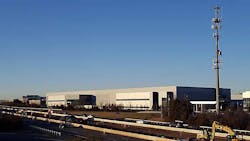Customers in many Digital Realty data centers will have faster to the Oracle Cloud through direct network connections, the companies said today. The partnership provides Oracle’s cloud offerings with access to a larger pool of the enterprise customers that represent some of their best prospects, while adding cloud options to Digital Realty facilities.
“Cloud is the fastest growing area of Oracle’s business and certainly the area they are giving the most attention,” said Sean Iraca, Vice President of Service Enablement at Digital Realty. “As we all know, everyone is using a multitude of cloud services these days, and we want to make sure that they have what they need to grow their own businesses.”
Oracle leases more than 500,000 square feet of data center space in Digital Realty properties, making the database specialist the fourth-largest customer for the data center developer. That makes Oracle an ideal candidate for Digital Realty’s connected campus strategy, which uses physical proximity and its fiber network to create connections between cloud and customers.
Today’s agreement offers access to Oracle Cloud through Oracle Cloud Infrastructure (OCI) FastConnect at 59 Digital Realty data centers in 14 markets, including Ashburn, Atlanta, Boston, Chicago, Dallas, London, Los Angeles, Miami, New York, Phoenix, Portland, San Francisco, Seattle and Silicon Valley.
“Customers require seamless connectivity from their data centers and networks to Oracle Cloud for their most demanding workloads and applications,” said Don Johnson, Senior Vice President Product Development, Oracle Cloud Infrastructure. “With Oracle’s FastConnect service via Digital Realty, customers can provision the dedicated and private connections they need today and easily scale with their growing business demands.”
Enabling Hybrid Clouds
Oracle FastConnect enables customers to set up a hybrid cloud by providing low-latency, private and dedicated connectivity to Oracle Cloud. On Digital Realty’s end, the key enabler is Service Exchange, a software-defined networking (SDN) service that allows enterprise customers to use a single interface to connect with cloud providers. Service Exchange is offered through a partnership with SDN specialist Megaport, and allows users to manage physical and virtual connections through a single portal.
“The Oracle agreement “builds atop the foundation we’ve laid with Service Exchange since the launch in November 2016,” said Iraca. “Adding Oracle to the existing AWS, Microsoft Azure and Google Cloud Platform offerings helps ensure that all of our enterprise customers, and all of the teams and workgroups within those organizations, have access to a full portfolio of cloud services.
“Interconnected multi-cloud services is a fast-growing area of our business,” Iraca added. “Securely connecting customers to the growing list of cloud-based services their businesses demand is paramount.”
Oracle is emerging as an intriguing player in the cloud computing wars. The company is known for enterprise business software, and has a vast base of existing users. In 2015 Oracle entered the IaaS market, which has been dominated by Amazon Web Services. Oracle Cloud offers elastic compute, storage and networking services on a subscription basis.
These IaaS services may be attractive to companies that are running applications on Oracle’s SaaS and PaaS platforms and want to reduce latency in moving data between their public and private clouds (eliminating the round trip to a private cloud at Amazon, for example).
Shifting to Leased Cloud Infrastructure
As Oracle builds momentum in cloud computing, it has shifted from building its own data centers to leasing wholesale space from data center developers, enabling it to accelerate its expansion. That has been an opportunity for Digital Realty, which has become one of the company’s major landlords. As such, it stands to benefit from additional cloud growth. As we’ve prebiously noted here at Data Center Frontier, if Oracle delivers on its cloud ambitions, it will almost certainly need more data centers.
“Oracle has some truly differentiated services based on pre-stacked, managed offerings that significantly lower the barrier to entry to cloud for our customers and offer a great deal of value in the markets we serve,” said Iraca. “The breadth of Oracle’s product portfolio, spanning from IaaS to PaaS and SaaS is attractive to a wide range of verticals, and helps make ours the most comprehensive set of offerings in the market today.”
An aerial view of Oracle’s Utah Compute Facility in South Jordan, Utah. (Image: Oracle Corp.)
As it has shifted its ambitions cloudward, Oracle has updated its data center strategy. Until 2015, Oracle ran its online services out of data centers in Austin, Utah and Scotland. It also houses servers with some third-party data center providers.
The evolution of the Oracle Utah Compute Facility (UCF) in South Jordan, Utah illustrates the ongoing changes in technology and best practices, and Oracle’s emphasis on continuous refinement of data center design to strike a balance between sustainability, cost and operational efficiency.
But the buildout of the Utah facility occurred over two years. By shifting to a wholesale approach – where customers lease finished suites of technical space – Oracle can fill data halls with servers on a shorter timeline. In recent projects, wholesale providers have demonstrated the ability to deploy new capacity from the ground up in as little as six months.
About the Author


